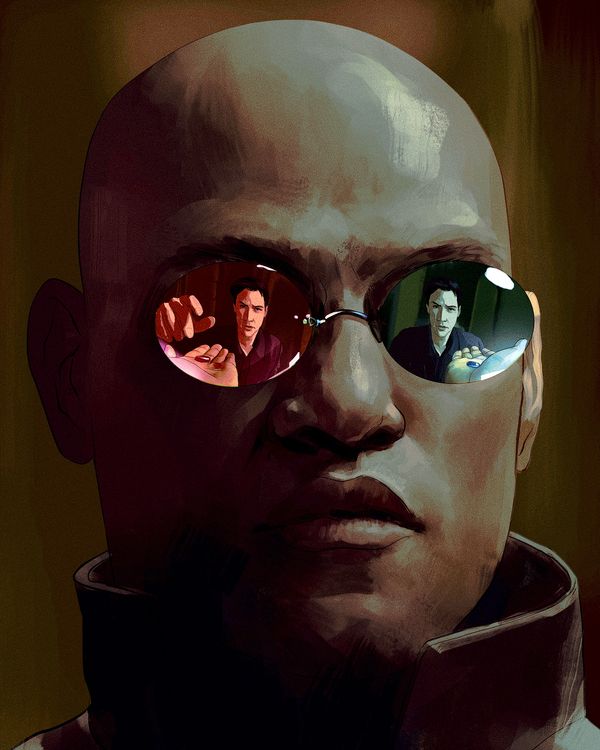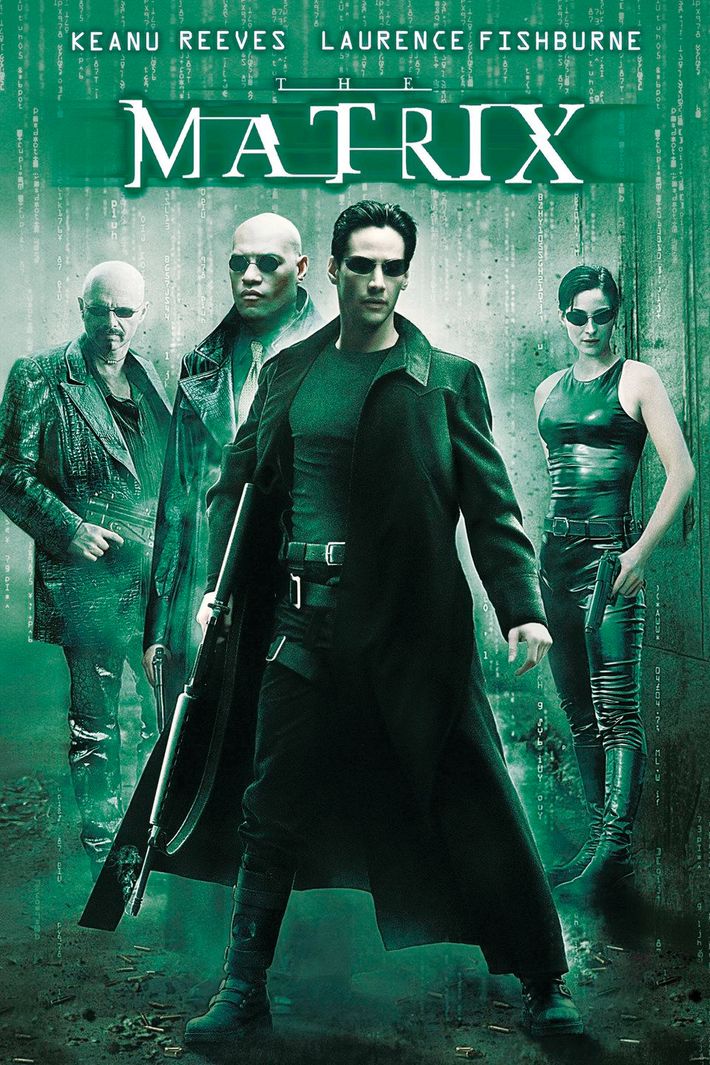
This article was published as part of a series that originally ran in February 2019. We are republishing it to mark the 25th anniversary The Matrix’s 25th anniversary.
Though made for a (relatively) big budget by a major studio and starring a recognizable name, The Matrix arrived as an unknown quantity in the spring of 1999. Would critics get it? Would audiences even show up? The answers were yes (mostly) and yes (decidedly). What first caught filmgoers’ attention via a weird-looking trailer in which Keanu Reeves dodged a bunch of bullets in slow-motion would soon become a pop-culture phenomenon that would inspire sequels and spinoffs and launch the careers of a pair of sibling filmmakers previously best known for one acclaimed low-budget crime movie.
The film seemed to come out of nowhere. It didn’t. In fact, if the stars didn’t align just right, and Warner Bros. hadn’t done the studio equivalent of taking the red pill and seeing what happened, it might not have happened at all. As we approach the film’s 20th anniversary, here’s a timeline of how The Matrix came to be, and what happened next.
June 21, 1965 and December 29, 1967
Lana (formerly Larry) Wachowski and Lilly (formerly Andy) Wachowski are, respectively, born in Chicago. Raised in the South Chicago neighborhood of Beverly, the siblings start creating together at an early age. Their early efforts include a radio play inspired by The Shadow and High Adventure, a game influenced by their passion for Dungeons & Dragons.
Spring 1983 and Spring 1985
Lana and Lilly graduate, respectively, from Chicago’s Whitney M. Young High School, a magnet school whose alums include Michelle Obama, Craig Robinson, and Vic Mensa. In high school, they had worked behind the scenes on school plays and saved for college by starting a house-painting business. But college won’t last long for either. Lana will enroll at Bard and Lilly at Emerson, but both will drop out after a couple of years. After some time in Portland, Oregon, Lana will return to Chicago, reunite with Lilly and start a construction business.
July 28, 1990
Random House publishes How I Made a Hundred Movies in Hollywood and Never Lost a Dime, director and producer Roger Corman’s memoir of his career making low-budget movies. After Lana reads it, the Wachowskis write Carnivore, a script about a soup kitchen that serves the flesh of the rich to the poor. Designed to be made on a shoestring budget, their first completed script is never produced — despite post-Matrix attempts to bring it to the screen by George A. Romero and Matrix cinematographer Bill Pope. It will, however, serve as a calling card.
September 1993
But first: comics. After traveling to New York, Lana lands a gig writing for Ectokid, a low-profile title whose third issue, dated November 1993, is credited to James Robinson and Larry Wachowski. The remainder of the series’ nine-issue run will be credited only to Larry Wachowski, but written by both Lana and Lilly, who will also collaborate on the Marvel-published Book of the Damned and Nightbreed. It’s a more significant first step in the siblings’ career than it might first appear. Each title is part of a short-lived line of comics created by horror writer Clive Barker, who helped prove that stories mixing fantastic elements with depictions of unconventional sexuality could find a mainstream audience. Ectokid is also drawn by Steve Skroce, a Canadian artist who will play a major role in The Matrix. Furthermore, it’s while attempting to conceptualize a comic of their own that The Matrix will start to take shape.
1994
Things start to take off for the Wachowskis. They sign with agent Lawrence Mattis, who remains their manager, and they finish the first script for The Matrix. But it’s another script that gets Hollywood’s attention. Assassins, a dark thriller, draws interest from both Dino de Laurentiis and Mel Gibson. The latter gives the Wachowskis $1,000 each to wait 24 hours so he can decide whether he wants to make it, but ultimately passes in favor of directing and starring in Braveheart. De Laurentiis then options it for $10,000. Warner Bros. production chief Lorenzo di Bonaventura signs the Wachowskis to a multi-script deal.
October 6, 1995
Assassins hits theaters in a form the Wachowskis will later call an “abortion.” At one point set to star Wesley Snipes and be directed by Joe Johnston, it ultimately becomes a Richard Donner–directed film starring Sylvester Stallone, Antonio Banderas, and Julianne Moore — after being rewritten by Brian Helgeland. The Wachowskis have to be dissuaded from trying to take their name off the film.
Late 1996
But this doesn’t mean they’ve soured on everyone with whom they’ve worked. They’ll soon work with de Laurentiis again, and Assassins producer Joel Silver will play a major role in The Matrix. Their relationship with Warner Bros. remains intact as well. In the years leading up to The Matrix they’ll work on scripts for V for Vendetta (made years later with the Wachowskis as producers), Plastic Man, and an an intriguing-sounding film they’ll describe to BuzzFeed years later as a “sort of Hitchcock-y thing about this guy stuck in a building.” In the wake of Assassins, they continue to lobby to write and direct The Matrix, but can’t quite move it forward. So they sidestep.
August 31, 1996
Bound debuts at the Venice Film Festival. Released from their Warner Bros. contract to work on their directorial debut, they shoot the low-budget thriller starring Jennifer Tilly and Gina Gershon, in Santa Monica over 38 days. Produced by de Laurentiis and distributed by Gramercy, Bound will become an art-house hit and attract attention both for its protagonists’ same-sex relationship and for the Wachowskis’ stylish, noir-inspired direction. The film proves they have the chops to make a movie of their own, and begins working relationships with actor Joe Pantoliano, who will play a major role in The Matrix, and cinematographer Bill Pope, who will serve as DP on all three Matrix films.
Spring 1997
The Wachowskis get the green light to make The Matrix on a $60 million budget. Getting to this point isn’t easy, however, requiring the support of both Silver and di Bonaventura. It also requires a 600-page comic-book-like rendering of how the film will look created by Skroce and Geof Darrow, an artist admired by the Wachowskis whose concept art will play a big role in the look of the film. But getting the go-ahead creates problems of its own. To save money, the film will be shot in Sydney, Australia.
Summer 1997
Casting necessitates finding actors willing to put in months of training and do the research required by the filmmakers, specifically reading books on philosophy and evolutionary psychology. Some famous names pass on the lead role of Neo, including Brad Pitt, Leonardo DiCaprio and, most famously, Will Smith (who, a few years later, suggests he would have “ruined” the movie). It also means persuading Hong Kong fight coordinator Yuen Woo-Ping to rearrange his schedule and work with actors untrained in fighting. And it requires creating special effects that had never been attempted before, most crucially the time-freezing “bullet time” effect created by John Gaeta. Some action movies have elaborate effects, some have martial arts, some have gunplay, but The Matrix would have to have all of the above. And for it to work, it would have to nail them.
Fall 1997
Months before shooting, training begins for the main cast. Reeves, Carrie-Anne Moss (Trinity), Laurence Fishburne (Morpheus), and Hugo Weaving (Agent Smith) commit to a grueling regimen overseen by Yuen. One problem: Reeves is already recovering from a herniated disc. He’ll undergo training while wearing a neck brace but be unable to kick until deep into the shooting schedule, forcing the Wachowskis to keep the action back-loaded to help facilitate his recovery. Further complicating matters: Moss will sprain her ankle and Weaving will need surgery when he injures his hip. Later, he’ll crack two ribs and hurt his wrist. “At that point,” he told Entertainment Weekly in 1999, “I thought, ‘Oh, who cares?’”
March 1998
Filming begins in Sydney after a Buddhist ceremony. It is, by all accounts, a demanding but harmonious process. And though the film goes over schedule, Warner Bros. likes what it sees and increases the effects budget.
August 1998
Filming ends and post-production begins. The Wachowskis will stay in Australia until November, then continue editing the film until shortly before its release. Meanwhile, there’s the small matter of how to sell the public on a movie with a twisty concept, potentially off-putting visuals, and headlined by a star whose box-office power had seen better days. Another sign of possible trouble: The previous year’s similarly themed Dark City struggled at the box office.
January 31, 1999
As part of the answer to that problem, Warner Bros. advertises the film during the Super Bowl, putting bullet time, Reeves doing kung-fu, and other striking images in front of the largest audience imaginable. In theaters, the trailers will cryptically tell (warn?) audiences, “In 1999, The Matrix Has You,” while Fishburne’s voice-over says, “No one can be told what The Matrix is. You have to see it for yourself.”
March 31, 1999
The Matrix makes its theatrical debut on the Wednesday before Easter and it soon becomes apparent that audiences agree: They do have to see it for themselves. Critical reception is also kind, with some notable exceptions. Variety’s Todd McCarthy dubs it “an eye-popping but incoherent extravaganza of morphing and superhuman martial arts” while Rolling Stone drags its “stunted script.” Others will be more sympathetic, and more in line with audiences. In Slate, for instance David Edelstein praises it as “one of the more lyrical sci-fi action thrillers ever made.” Soon, the film will become an instantly understandable cultural shorthand, and its central concept will become an easy metaphor for seeing the truth behind lies. Meanwhile, the Wachowskis retreat to Chicago. Already publicity shy, they have a no press clause in their contract and do only limited interviews with a few major outlets, waving off talk of sequels when asked by EW.
April 20, 1999
There is a dark side to success, of course. In the wake of the Columbine massacre, The Matrix will become a focal point for discussion of violence in entertainment, thanks in part to a resemblance between the costumes favored by its protagonists and the trench coats worn by Eric Harris and Dylan Klebold. (That and the film’s open fetishization of firearms, of course.) Years later, in an example of how easily culture can be twisted and misappropriated, the film will be adopted by the alt-right “red pillers” who view what they see as liberal distortions of reality as akin to the illusion of The Matrix.
September 21, 1999
The Matrix is released on DVD, becoming a best seller while helping to popularize the then-new format by showing off what it could do and packing the disc with making-of features and commentary tracks.
March 26, 2000
The Matrix wins an Academy Award in every category in which it’s nominated: Best Editing, Best Sound Effects Editing, Best Sound, and Best Visual Effects.
March 1, 2001
Filming begins simultaneously on The Matrix Reloaded and The Matrix Revolutions, sequels that will be released within a few months of each other in 2003. Anticipation begins for films fans now expect to be even more mind-blowing than what’s come before.
More From This Series
- The Beatific Imperfection of Keanu Reeves in The Matrix
- The Matrix Taught Superheroes to Fly
- Neo’s Stunt Guy on How The Matrix Changed Action Forever


